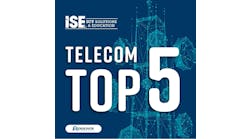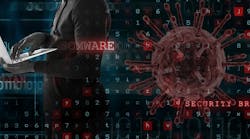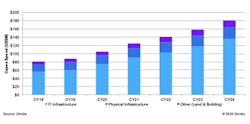Recent updates include notices from Broadbandsearch.net, Technologent, IPXO, NordVPN Teams, Omdia, Parks Associates, Terry Savage, US Dept. of Labor, and US News.
Visit https://isemag.com/category/safety/telecom-covid-19-network-impact-wireless-wireline/ often to find more COVID-19 Impact Updates.
3 Opportunities Covid-19 Created for the Internet Industry
The pandemic had a twofold effect on the Internet Industry, as, alongside the increased strain on the network and a wave of newly-surfaced threats, it also created new opportunities for growth and innovation.
The Internet is one of the industries that felt the pandemic’s effect in full-force, as it had to withstand the sudden surge of users to the online space. That said, alongside the difficulties it posed, the unforeseen circumstances have simultaneously paved the way for increased network security, accelerated IoT adaptability in supply chains, as well as significantly pushed cloud adoption across a multitude of sectors.
Vincentas Grinius, CEO at IPXO, and Žilvinas Vaičkus, Head of Infrastructure at IPXO, elaborated on these prospects and how they will continue to shape the industry.
Security patch-up
The pandemic brought along a staggering wave of cyber threats: spikes in e-mail and phishing scams, a 400% jump in remote desktop protocol (RDP) attacks, personal account hacking, and re-selling via the dark web, and others. While this undoubtedly raised a lot of red-flags as to how novel threats could be mitigated, it also exposed gaps that were previously overlooked or simply deemed non-priority. This called market players to fortify their security measures, as well as patch up old frailties, for a well-rounded cyber resilience.
"The growing intensity of malware attacks quickly exposed all of the underlying security gaps that have been previously neglected. This was a wake-up call for many, showing that cybersecurity is not one of the things you can compromise on," said V. Grinius. "We’ve noticed the surge of attacks too but they were halted in their tracks, as we continuously enhance our safeguards. Now, with more companies re-evaluating and upgrading their security, the network went through sort of a patch-up, which will also help to navigate through the risk landscape going further."
Ž. Vaičkus noted the situation paved the way for embedding cybersecurity knowledge into the company culture, which will help uphold higher security standard hereafter: "It has become an all-hands-on-deck situation, showing that cybersecurity is not exclusively dependent on chief information security officers, rather the entire team. Especially when the majority of it is working remotely,"
"At-home systems usually have fewer security layers, which makes it easier for hackers to breach the company’s network. However, if employees are aware of the most common scams, they usually think twice before opening any documents from suspicious senders, which significantly minimizes external risks to the network.”
Fast-Track IoT Adoption
In April, disturbances across the global trade supply chains were a clear indication that the world was still trying to understand the true extent of the pandemic and how to adapt to continue business as usual. With factories idle and the majority of the workforce in lockdowns, minimizing the need for human capital to maintain operations encouraged to step on the gas in terms of IoT integrations. With near real-time asset management, increased efficiency, and enhanced employee safety, IoT could be key for retailers to succeed in the post-pandemic world.
"Over the past few months the pandemic accelerated IoT integration by at least a year’s worth of progress," said V. Grinius. "Looking ahead, the flexibility and efficiency smart supply chains offer will help guarantee a higher-level of reliability and enable to better withstand market volatility, as well as keep employees safe till it all dials down. Without the circumstantial push, we would not have seen such a rapid transformation process."
Multi-Sector Cloud Adoption
Cloud computing emerged as one of the few lifelines for struggling businesses: some experts say it saved half of the vendors from complete collapse. It enabled office workers, heavily-reliant on remote system access and video conferencing, to continue work from home. Retailers, on the other hand, used the technology to deal with the e-commerce boom, as customers turned their heads to online shopping. Even the healthcare sector embraced cloud solutions to better protect patient data.
"Cloud adoption was already on the rise before COVID-19 hit — but this certainly gave it an extra push," noted Ž. Vaičkus. "More importantly, the benefits were recognized across a multitude of different industries, which may not have had cloud integrations in their checklist any time soon. The widespread adoption of cloud will not only help mitigate some of the pandemic pressures but will also fuel faster advancement later on, which is crucial for everyone aiming to thrive post-COVID.”
About the Company: IPXO, formerly known as Heficed’s IP Address Market, is an IP resource management platform, which enables to monetize unused IP addresses via lease. Reportedly having outgrown its current position as part of Heficed’s framework, it will continue to grow and improve as a separate business entity, with the full switch predicted at the beginning of 2021. IPXO will be equipped with advanced features such as reputation monitoring, delegated RPKI, WHOIS, Geo object management, BGP announcement control, and open API. More information: www.ipxo.com.
Impact of COVID-19 Pandemic and Consumer Lifestyle Changes on Tech Use at Home Addressed
International research firm reports 30% of consumers own a smart home device, 52% intend to purchase a smart home device in the next 12 months, and 67% own and use at least one Internet-connected video device.
International research firm Parks Associates welcomed connected home ecosystem players during its CONNECTIONS™ Community Virtual Sessions, hosted as part of the 24th annual CONNECTIONS conference in 2020. The firm, celebrating its 35th year in 2021, shared its latest consumer and industry data highlighting growth strategies, case studies, and recommendations for the smart home, connected health, tech support, energy management, and consumer electronic industries.
Parks Associates reports that 30% of US broadband households own at least 1 smart home device and 52% intend to purchase a smart home device in the next 12 months. Currently 67% of US broadband households own and use at least 1 Internet-connected video device, and usage of broadband and other home services has increased dramatically over the past 6 months, as have NPS scores for service providers, as a result of the COVID-19 pandemic.
“Consumers have made dramatic changes in their lives this year, repositioning the home as the true center for all aspects of daily life,” said Elizabeth Parks, President, Parks Associates. “2021 will be a year of further expansion for connectivity in the home, with consumers adopting and experimenting with innovative and useful solutions. We are excited to bring industry players together to talk about current and future challenges and opportunities.”
Parks Associates data:
• Professional monitoring revenue for the US residential security sector will total $15.74 billion in 2020, with smart home services accounting for $1.2 billion.
• 41% of US broadband households are concerned about hackers getting access to their devices.
• 64% of smart home device owners report setting up at least one smart home device themselves, and 51% experienced at least one type of problem when setting up their device.
• As a result of the COVID-19 pandemic, 26% of US broadband households are more interested in smart home solutions that keep their home and family safe, and 24% are more interested in whole-home Wi-Fi solutions.
• Adoption of home control systems experienced a 38% year-over-year growth rate in 2019.
• In May 2020, 41% of US broadband households reported using a telehealth service in the past 12 months, up from 15% from the previous year, due in large part to the COVID-19 pandemic.
• US households will have an average of 20 connected devices by 2025.
CONNECTIONS™ visionary speakers included representatives from AARP, ADT, Alarm.com, ANGI Homeservices/Handy, Comcast, CommScope, CUJO AI, Electronic Caregiver, EnergyHub, Frontdoor Home, KPN Ventures, Mill Creek Residential, Nokia, Rapid Response Monitoring, and Vivint Smart Home.
CONNECTIONS™ Community Sponsors included Sutherland Global Services, Alarm.com, Bitdefender, Nice, Cox, Intellithings, Cirrent, Everise, MMB Networks, ServiceLive, Zen Ecosystems, Firedome, Inspire, Mercku, Olibra, Ossiaco, Plume, Tuya, Zigbee Alliance, Z-Wave, Aprilaire, Asurion, Gadgeon, and Wi-Charge.
CONNECTIONS™ provides networking opportunities combined with visionary keynotes and conference sessions focused on technology innovations, consumer research, product and service adoption and trends.
To request data, contact Rosey Ulpino, [email protected], 972.490.1113.
ABOUT CONNECTIONS™
Parks Associates’ 24th annual CONNECTIONS™ is a virtual conference focused on technology innovations, consumer research on adoption and trends, and product and service forecasts. www.connectionsconference.com
COVID-19 Pandemic: Reasons to Increase Your Identity Fraud Security
Keep your personal information, SSN, and more, protected. Here are a few resources to look into for fraud protection.
US News article: Best Identity Theft Protection Services of 2020
https://www.usnews.com/360-reviews/identity-theft-protection
Terry Savage website: Identity Theft – What To Do
https://www.terrysavage.com/identity-theft-update/
Zander Identify Theft: The Smarter, More Affordable ID Theft Plan
https://www.zanderins.com/identity-theft-protection
10 Best Identity Theft Protection of 2021
Here’s a handy guide to safeguarding your identity.
https://www.consumersadvocate.org/id-theft-protection/a/best-id-theft-protection?utm_source=bing&utm_medium=cpc&utm_campaign=f%20Identity%20Theft&utm_term=identity%20theft%20protection&utm_content=Identity%20Theft%20protection%20Phrase
Will COVID-19 Break the Internet?
The crisis brought on by the emergence of the novel coronavirus COVID-19 has touched our lives in so many ways.
However, this crisis is unique in that to emerge from it with the minimum of human cost, the vast majority of us can do nothing more except stay at home. At the same time, public health professionals do the difficult yet heroic work of treating those infected while also seeking out a long-term solution that will eliminate the term "new" when we talk about going back to normal.
Next to the loss of human lives, the global economic loss is also unprecedented. The impact of shuttering businesses around the world has been nothing short of immense, but it would be even more significant if it were not for the Internet. Think of how much of our lives we can continue with during this crisis thanks to the existence of the world wide web – productivity, learning, socializing entertainment, and much more.
Of course, relying solely on the Internet for these things does leave a hole, but it’s certainly better than nothing and makes it much easier to live with the restrictions needed to limit the spread of the virus and save lives.
There are several sections to the report:
• Can The Internet Cope?
• How the Internet Has Handled COVID-19
• Why Study Internet Speeds?
• How We Conducted Our Study
• Median Internet Speeds During the Dovid-19 Quarantine Crisis: Complete Results (Several tables and graphs show information from several US cities.)
• Ten US Cities With the Biggest Improvement in Median Download Speed During COVID-19 Lockdowns (3/1/20-5/20/20)
• Why is My Internet Still Slow?
• Moving Forward
How the Internet Has Handled COVID-19
Here is a quick summary of the most important information we gleaned from our study.
For more information, please visit https://www.broadbandsearch.net/blog/covid-coronavirus-internet-speeds.
6 Ways Hybrid Cloud Service Meets Needs of Remote Workforce
Remote work is here to stay, and the hybrid cloud is a crucial component of this new reality. Global IT Solutions provider Technologent CIO and VP of Professional Services Mike McLaughlin shares the advantages of this growing technology.
Before COVID-19, the cloud was already emerging as an essential IT service business need. But with the number of employees permanently working remotely around the globe set to double in 2021, from 16.4% to 34.4%,(1) the future of business appears to rest solidly on a hybrid model of on-site and cloud computing access. "A hybrid solution that allows workers to freely transition from on-site work to remote work is the future," says Mike McLaughlin, CIO and Vice President of Professional Services for Technologent, a global IT solutions provider. "It must be scalable, flexible and secure, and those CTOs and IT Departments who don’t embrace this will be at a tremendous disadvantage."
A hybrid cloud solution model combines some mix of a private cloud platform with a public cloud and/or an on-site infrastructure.(2) Remote work was on the rise even before the pandemic, and it has been shown that employee satisfaction and productivity both increase when remote work is properly supported.(3) Proper implementation requires optimal data security and access, as well as IT hardware-related support needs. McLaughlin advises that partnering with a strategy and implementation partner, like Technologent, can assist companies in making the tough decisions about infrastructure and effective cloud strategies that will be best for remote work today and in the future.
Meeting the technology infrastructure needs of a remote workforce via the cloud is not a simple task, even for the largest enterprise. Is it a choice between virtual desktop infrastructure (VDI), virtual private network (VPN), or software defined perimeter (SDP) or a combination of these and other solutions? There are cost and time challenges involved, too, so businesses want to make informed decisions. But the advantages are many as well, which is why updating this technology now can better position companies for today’s reality and for what may come tomorrow.
Advantages of a cloud hybrid
• Agility—A cloud hybrid offers B2B enterprises, retail businesses, and remote workforce managers the ability to quickly adapt to change. It better supports the reality of a growing remote workforce.
• Cost—Rather than housing all data on a private, on-site server, a cloud hybrid provides the option of storing less sensitive data on a public cloud. This saves money by limiting a company’s investment in infrastructure, plus they only pay for their cloud services on an as-needed basis.
• Control—If your business grows, a hybrid cloud can be scaled up easily, and it allows businesses to automatically respond to demand.
• Innovation—Speed to market can make or break a company today. A cloud hybrid lets companies pivot to meet changing demands.
• Continuity—In the event of a disaster or pandemic, a cloud hybrid lets a business continue operations with minimal downtime and helps ensure the backup of key data.
• Security—Implementing security measures such as encryption, automation, access control, orchestration, and endpoint security is left up to each company to control.
"The cloud infrastructure is ready," says McLaughlin. "What clients will need is a way to help them organizationally make the transition, as well as a cybersecurity approach that covers gaps." The pandemic’s work-from-home high point dropped from 51% in April to 33% in October, but now that U.S. workers have had the experience, about two-thirds want to continue to work remotely.(4) That requires an operating model transition, which has as much to do with the people and process as the technology. Technologent is that partner—with services and solutions such as OnePointSM CMaaS, DB Automation, Remote Site Automation and cloud transformation—to help B2B enterprises, retail businesses and remote workforce managers make this crucial transition.
Resources and Notes
1. Chavez-Dreyfuss, Gertrude; "The number of permanent remote workers is set to double in 2021"; 23 October 2020; World Economic Forum; weforum.org/agenda/2020/10/permanent-remote-workers-pandemic-coronavirus-covid-19-work-home/
2. Hastreiter, Nick; "What’s the Future of Cloud Computing?" accessed 6 November 2020; futureofeverything.io/future-of-cloud-computing/
3. Chris DeRamus. "The Cloud Is the Backbone of Remote Work"; Forbes; June 16, 2020; forbes.com/sites/forbestechcouncil/2020/06/16/the-cloud-is-the-backbone-of-remote-work/#76c695824dc9
4. Brenan, Megan; Casna, Kathryn; "COVID-19 and Remote Work: An Update"; 13 October 2020; Gallup; news.gallup.com/poll/321800/covid-remote-work-update.aspx
About the Company: Technologent is a Global Provider of Edge-to-EdgeTM Information Technology Solutions and Services for Fortune 1000 companies. They help companies outpace the new digital economy by creating IT environments that are fast, flexible, efficient, transparent, and secure. Without these characteristics, companies will miss the opportunity to optimally scale. Technologent mobilizes the power of technology to turn vision into reality, enabling a focus on driving innovation, increasing productivity, and outperforming the market. For more information, visit www.technologent.com.
Data Center CapEx Continues to Grow Despite COVID-19
Demand for data center services continues to rise despite COVID-19 and its economic impacts, according to Omdia’s Cloud & Colocation Data Center Capex Market Tracker. Data center capex by cloud and colocation service providers is expected reach $180 billion in 2024, growing at a 15.7 percent compound annual growth rate (CAGR) from 2020 through 2024 as service providers work to stay ahead of customer demand.
Cloud and colocation service providers continue to benefit from the sustained secular demand trends already in place, but enterprises will continue to accelerate their digital transformation activities as they mitigate the risk of potential unknown future fallout from the pandemic and its economic impact.
Data Center CapEx Forecast by Equipment CategoryAlan Howard, principal analyst at Omdia, commented: “Cloud and colocation service providers have been benefactors of increased SaaS and network customer demand from the pandemic response necessitating remote working and educating. Whilst there has been some challenges and delays in data center projects driven by the pandemic, we are not seeing or anticipating a pull-back on investing in the very heartbeat of services delivery, which is the data centers themselves.
"Based on existing evidence and data, the trajectory of data center capex spending will continue to grow to meet anticipated demand. Spending in each category is not a smooth flow in each period or each year. For example: IT infrastructure equipment spend is impacted by refresh cycles, trade regulations and supply chain issues; physical infrastructure equipment is also impacted by construction cycles and data center space availability as well as IT equipment deployment timing."
About the Company: Omdia is a global technology research company, established following the merger of the research division of Informa Tech (Ovum, Heavy Reading and Tractica) and the acquired IHS Markit technology research portfolio*.
We combine the expertise of over 400 analysts across the entire technology spectrum, analyzing 150 markets publishing 3,000 research solutions, reaching over 14,000 subscribers, and covering thousands of technology, media and telecommunications companies.
COVID-19 Is Changing the Digital Threat Perimeter
Digital security in the post-pandemic business landscape
According to the global research and advisory firm Gartner, spending on cloud security is predicted to be the fastest riser of all cybersecurity markets, with an expected increase of 33%, driving the market to an expected $585M this year.
In fact, cloud security is the smallest but fastest-growing segment of the cybersecurity market, driven by the small initial market size and companies’ opting for cloud-based cybersecurity solutions.
In March, when the global pandemic started, the business VPN solution NordVPN Teams saw a 165% usage spike and an almost 600% increase in sales overall, reflecting the unprecedented need for securing remote access. Since then, the digital threat to bandwidth has increased dramatically.
"In this rush to adapt, many companies have neglected or ignored both their risk and change management processes. Now that many employees have shifted to remote work — in addition to organizations being distracted trying to handle the virus — security and risk management teams need to be more vigilant than ever," says Juta Gurinaviciute, Chief Technology Officer at NordVPN Teams.
Cybersecurity risks posed by remote work can be categorized into 3 key areas: people, places, and technology.
The risks presented by people include employees falling prey to social engineering, phishing, and targeted attacks that aim to capture users’ credentials or make them accidentally download malware.
Place-related risks include connecting to corporate networks from unsecured homes or public Wi-Fi.
Technological risks have to do with using personal or unauthorized devices that aren’t in line with corporate security policies, and patching hardware.
"Despite the speed, we’re still at the early stages of the remote work revolution. If you have 5,000 employees, you now have 5,000 remote offices to protect," the NordVPN Teams expert adds.
On the other hand, large, global businesses are continuing to encourage remote work for their employees. Larger companies are better suited to remote work primarily due to their access to innovative collaboration, resources, budgets, and communication services. Alternatively, many SMEs are quicker to adapt, and thus the transition may be easier for them. However, a lack of security education and resources has made SMEs a prime and vulnerable target for attacks.
Gurinaviciute comments: "Cloud computing has proven battle-ready during COVID-19, demonstrating it can support unplanned, unexpected, and dynamic needs."
COVID-19 has set a new baseline for effective and secure remote work, and we should assume that many organizations will continue to utilize remote and distributed workforces after the pandemic ends. Gartner’s HR survey reveals that 41% of employees are likely to work remotely at least some of the time in the post-pandemic world. In this new normal, cybersecurity leaders will not only have to protect their organizations in remote settings but will also need to make cybersecurity an integral part of their plans to deliver business value.
About the Company: NordVPN Teams is a cloud-based VPN for business from the world’s most advanced VPN service provider, NordVPN. NordVPN Teams has a full range of features to ensure convenience and powerful digital protection for organizations of all sizes, freelancers, and remote teams. NordVPN Teams offers advanced 256-bit encryption, secure remote access, malware blocking, two-factor authentication, unsecured traffic prevention, automatic connection on Wi-Fi networks, and 24/7 customer support. NordVPN Teams is available on all major platforms. For more information: nordvpnteams.com






